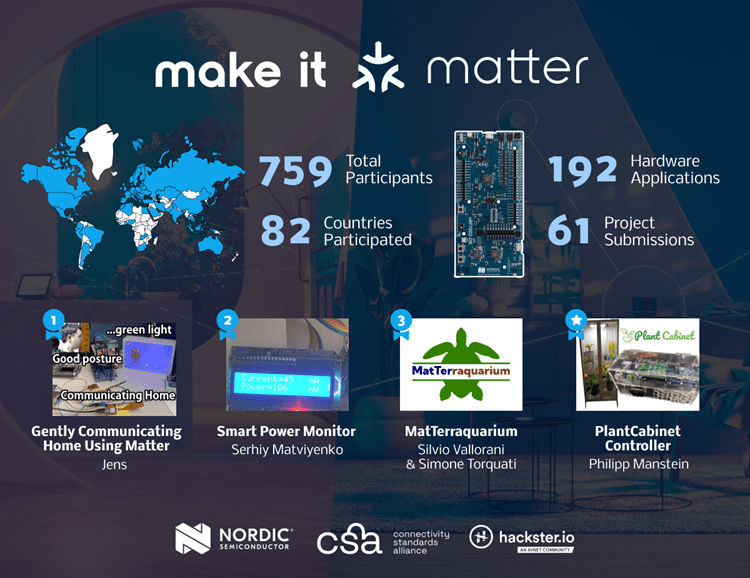Make it Matter design contest winner demonstrates smart home-connected wearable to help remind users to maintain better posture or do their homework
2024

The Bluetooth LE sensor and Matter home network-powered solution took out the $2,000 top prize in the Nordic Semiconductor and Hackster.io competition
Make it Matter powered by Nordic nRF5340 SoC
Harnessing the collective engineering expertise of Hackster's worldwide community, the Make it Matter competition challenged engineers and makers to create Matter-ready smart home applications with the goal of facilitating knowledge-exchange among diverse regions and communities. Projects could be developed using any of the nRF5340 SoC-based DKs from Nordic Semiconductor, including the nRF7002 DK, nRF5340 DK and the Nordic Thingy:53. As part of the competition Nordic gave out 100 nRF7002 Development Kits (DKs), accompanied by an nRF52840 Dongle to encourage participants to innovate and create projects aligned with the contest’s central goal. In total the contest had 759 registered participants, 192 hardware applications, and 61 submissions. Judges from both Nordic Semiconductor and the Connectivity Standards Alliance (CSA) reviewed the final submissions.“As judges we were hugely impressed by the high quality submissions, and there were many outstanding candidates for the prizes,” says Finn Boetius, Product Marketing Engineer at Nordic Semiconductor and competition judge. “Congratulations to all the winners, but it’s wonderful to see the developer community is as healthy and innovative as ever.”
Bluetooth LE- and Matter-powered technology
The winning wearable project employs a body-worn Bluetooth® LE-powered inertial measurement unit (IMU) and flex sensors—used to monitor the wearer’s posture—connected to a Bluetooth LE to Matter bridge. The bridge enables the sensors to connect to any Matter smart home device—for example, smart lighting—to provide a visual prompt to the user to correct their posture if the sensors detect they are slouching or sitting in a non-optimal position. Alternatively, the device could be configured to perform as a homework reminder for children, shutting down power to the television or turning the lights red until they start their homework.
Marte Myrvold, Nordic Semiconductor Application Engineer and competition judge added: “I was amazed by the exceptional work Jens put into his smart home posture project. Beyond its immediate application, the project opens up possibilities for countless smart home use cases that will inspire the developer community for years to come. His high level of creativity, thoroughness, and deep understanding of Matter makes him a well-deserved winner of the Make it Matter contest.”
Smart power and smart habitats
The second and third placed entries received a $500 and $300 virtual gift card, while 10 further runners up received a Nordic kit to the value of $100. One wild card entry also received a smart home hub to the value of $500.
Second place in the competition was awarded to a smart power monitor developed by Serhiy Matviyenko. Unlike traditional power monitors that only display total energy consumption, Matviyenko’s smart monitor measures parameters such as power, current, voltage, AC frequency, and leakage current. It also has the capability to detect overcurrent and overvoltage conditions and can automatically switch devices on or off based on predefined limits.
“This is another thing enabled by a unifying standard like Matter,” says LaPré. “This could be done before, but different ecosystems and different power-use protocols reduced the value of such systems. Now all power use in the home can be monitored. There are so many downstream uses of this information in energy management systems, managing the total load of your house at peak cost times, or when your solar panels can better support it, or preventing your electric vehicle charger from overloading the whole system.”
Third place was awarded to Silvio Vallorani and Simone Torquati for their ‘MatTerraquarium’, a smart habitat controller for pet turtles that provides Matter-powered environment control—for example heating and water temperature—using any commercial home automation device. The wild card winner was Philipp Manstein’s ‘PlantCabinet Controller’, a smart garden assistant that employs Matter to control and measure environmental conditions in indoor plant cabinets.